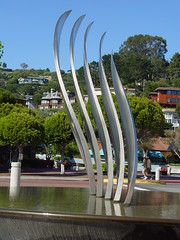 Tiburon recently released its draft Housing Element, the document required by ABAG every seven years. The document reflects the challenge of accommodating low-income residents in a high-income and largely built-up city, a challenge that all of Marin's communities have been forced to face. Tiburon answered the call with substantive proposed changes to its zoning and ordinance laws that should break the affordable housing deadlock in the town.
Tiburon recently released its draft Housing Element, the document required by ABAG every seven years. The document reflects the challenge of accommodating low-income residents in a high-income and largely built-up city, a challenge that all of Marin's communities have been forced to face. Tiburon answered the call with substantive proposed changes to its zoning and ordinance laws that should break the affordable housing deadlock in the town.
The strategies Tiburon currently in place are fairly common in Marin, although they have faced limited success since the last housing element:
- Inclusionary zoning laws, which force developers to include affordable housing in their developments
- Density bonuses for developers that make more affordable housing than required
- Affordable housing zoning overlays (AHOs), with lower barriers for affordable housing construction but with higher affordable housing mandates.
Commercial linkage fees, which force new commercial developments to pay a fee towards affordable housing, has been suggested by the town council but it has been stuck in limbo since 2005.
It is not difficult to see why these strategies have failed to generate much affordable housing, as each constrains developers in an already constrained market. If a developer includes affordable housing, the most generous restrictions are about 20.7 units per acre, roughly that of single-family attached homes (rowhouses); a maximum lot usage of 35%; and a 3-story height limit. This gives developers a very small building envelope to work with when looking at any new construction. As well, the cost of development is quite high, around $300 to $500 per square foot, including land acquisition. Add the affordable housing requirements and it becomes extremely difficult to thread the needle and make a development profitable. The AHO loosens these requirements somewhat, boosting density to 24.8 units per acre, but includes price controls on more than 60% of a development's units, an impossibly high amount.
The Housing Element as written does loosen these restrictions. One goal – H-aa, if you're wondering – lowers AHO's affordable housing requirement to only 25%. Another, goal H-y, introduces flexibility to the general zoning code: studios and one bedroom apartments count as 0.5 and 0.66 units, respectively, and parking minimums are decreased given that many low-income residents are carless. This opens the possibility of a one-acre, three story apartment building with 59 studio apartments or 37 one-bedroom apartments – still less than what such a building could normally support in the absence of density maximums, but far more than what Tiburon would otherwise allow.
This is far different from the approach taken by Novato, which had an incredibly contentious mark-up period for its Housing Element. Novato tries to encourage nonprofits to build affordable housing projects on vacant lots scattered throughout the city, building concentrations of poverty among the market-rate, single-family detached homes. Tiburon's plan would encourage mixed-income developments in already high density areas, concentrating people where they would do the most good for the town.
At least, that's the theory. Unfortunately, only one available and earmarked site is downtown, at 1555 Tiburon Boulevard. Granted, it would be wonderful infill development. Built on the site of an abandoned supermarket and its parking lot, the site would be immediately accessible to the town core, two bus lines, and the Blue & Gold Ferry to San Francisco. Other sites would likely strain the town's infrastructure. The Reed School site is almost a mile from the ferry, putting it out of easy walking distance to the town's primary transit feature, while the Cove Shopping Center site is hardly accessible to transit at all, save those bus lines. The remaining sites examined are already zoned for market-rate housing that moderate income families can afford.
Despite problems with siting, the Tiburon Draft Housing Element presents a good way forward. Especially exciting is the change to densities, potentially opening a new market for developers that would otherwise find studio and one-bedroom apartments impossible to build in the town. It dovetails well with plans to improve downtown vibrancy, which calls for more housing in the commercial core. Still, it remains to be seen whether the plan will be any more effective in adding housing than the last Housing Element. No matter, though: the next element is due in just three years.
Tiburon's Draft Housing Element will go before the Planning Commission on January 11. You can find the document on the town's website.